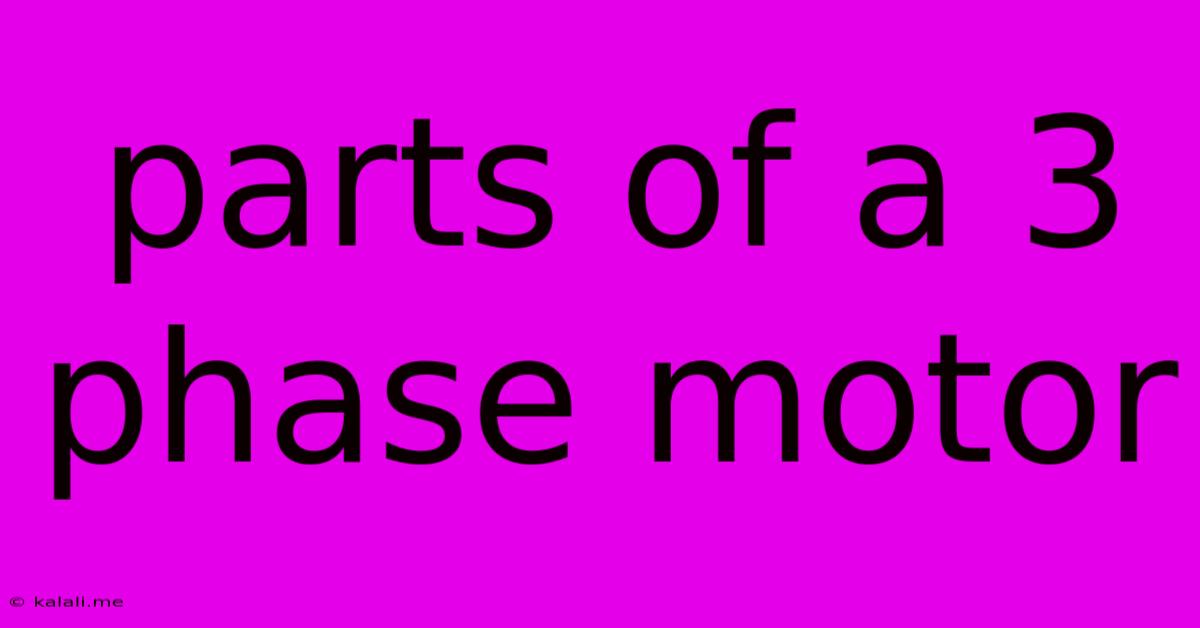Parts Of A 3 Phase Motor
Kalali
Jun 15, 2025 · 3 min read

Table of Contents
Understanding the Components of a Three-Phase Motor: A Deep Dive
Understanding the inner workings of a three-phase motor is crucial for anyone involved in industrial applications, maintenance, or electrical engineering. This comprehensive guide breaks down the key components, explaining their functions and how they contribute to the motor's overall operation. This detailed exploration will help you troubleshoot issues, understand motor specifications, and appreciate the complex yet elegant design of these powerful machines.
1. Stator: The Stationary Powerhouse
The stator forms the stationary outer part of the three-phase motor. It houses several critical components:
-
Stator Frame: Provides structural support and protection for the entire motor. It's typically made of cast iron or steel, offering durability and resistance to vibration.
-
Stator Core: A laminated core made of thin, insulated steel sheets. This construction minimizes eddy current losses, which are significant in high-frequency AC applications. The laminations are stacked to create slots, which house the stator windings.
-
Stator Windings: These are the conductors where the three-phase AC power is supplied. They are precisely wound within the stator slots to create a rotating magnetic field. The configuration of these windings (e.g., star or delta) dictates the motor's voltage and current characteristics. Proper winding design is essential for efficient motor operation. Understanding the winding arrangement is crucial for troubleshooting and repairs.
2. Rotor: The Rotating Heart
The rotor is the rotating inner part of the motor. There are two main types of rotors:
-
Squirrel Cage Rotor: The most common type, featuring conductive bars embedded in the rotor core. These bars are shorted at both ends by end rings, forming a "cage"-like structure. The simplicity and robustness of this design make it ideal for many industrial applications. Its simplicity leads to lower manufacturing costs and easier maintenance.
-
Wound Rotor: This type features independent windings on the rotor, similar to the stator windings. These windings are connected to slip rings, allowing external resistance to be added to control motor speed and torque. While offering more precise speed control, wound rotors are more complex and expensive than squirrel cage rotors. They are frequently employed in applications requiring variable speed control and high starting torque.
3. Other Essential Components
Beyond the stator and rotor, several other components contribute to the motor's functionality:
-
Bearings: Support the rotor shaft and allow for smooth rotation, minimizing friction and wear. Different bearing types are used depending on the motor's size, speed, and application. Regular lubrication and inspection are vital to maintain bearing integrity and prevent motor failure.
-
Shaft: The central rotating component that connects the rotor to the driven load. It transmits the mechanical power generated by the motor. The shaft's material and diameter are carefully selected to withstand the torque and stress generated during operation.
-
End Shields: Cover and protect the ends of the motor, holding the bearings in place. They also often house the terminal box for electrical connections. Proper sealing is crucial to prevent contamination and ensure motor longevity.
-
Terminal Box: Provides a safe and convenient point for connecting the motor to the power supply. Clearly labeled terminals allow for easy wiring and identification of the three phases.
-
Fan: Many motors incorporate a cooling fan, either directly mounted to the shaft or externally attached, to dissipate heat generated during operation. Adequate cooling is essential for preventing overheating and extending motor lifespan.
Conclusion: A Powerful Synergy
Each component of a three-phase motor plays a vital role in its overall performance. Understanding the function of each part allows for better maintenance, troubleshooting, and a deeper appreciation for the engineering marvel that powers countless industrial applications. From the robust stator frame to the precisely wound rotor, each piece contributes to the powerful and efficient operation of this ubiquitous machine. Regular inspections and maintenance, focusing on these key components, will significantly extend the service life and efficiency of your three-phase motors.
Latest Posts
Latest Posts
-
How Many Players On Hockey Team
Jun 16, 2025
-
What Is The Gap Between Two Neurons Called
Jun 16, 2025
-
The Law Of Demand Implies That
Jun 16, 2025
-
Which Computer Component Executes Instructions Provided By Computer Programs
Jun 16, 2025
-
University Of San Diego Sat Scores
Jun 16, 2025
Related Post
Thank you for visiting our website which covers about Parts Of A 3 Phase Motor . We hope the information provided has been useful to you. Feel free to contact us if you have any questions or need further assistance. See you next time and don't miss to bookmark.